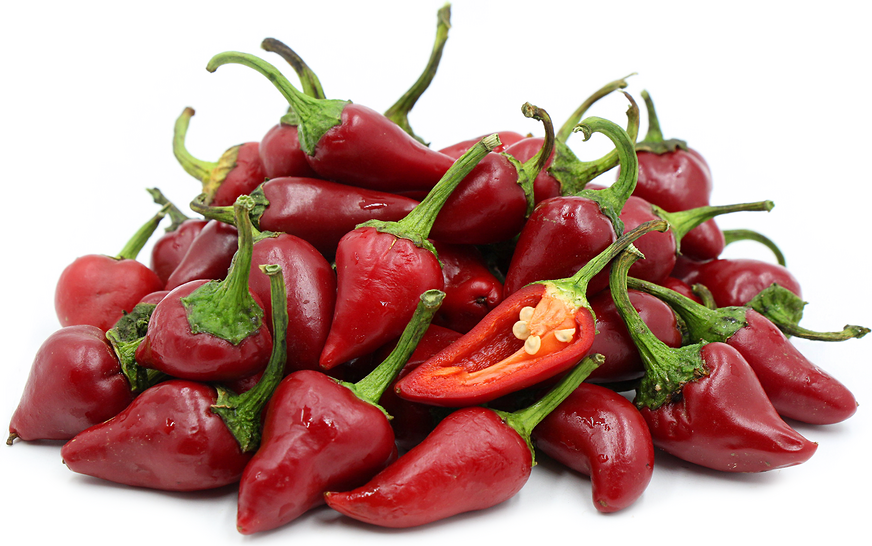


Calabrian Chile Peppers
Estimated Inventory, lb : 0
This item was last sold on : 11/11/24
Description/Taste
Calabrian chile peppers are round to conical, bulbous pods, about the size of a large cherry, that can be curved to straight in shape and taper to a point on the non-stem end. The skin is shiny and waxy, ripening from green, yellow, to dark red when mature, and have a short, squat, green stem. Underneath the skin, the flesh is bright red, thick, crisp, and aqueous, encasing a central cavity filled with a few round and flat, cream-colored seeds. Calabrian chile peppers are traditionally left to age on the vine and are hand-picked when they start to show a slightly wrinkled exterior. When fully ripe, the peppers have a fruity, smoky flavor mixed with a moderate to hot level of spice.
Seasons/Availability
Calabrian chile peppers are available in the late summer through fall.
Current Facts
Calabrian chile peppers, botanically classified as Capsicum annuum, are small, dark red pods that are members of the Solanaceae or nightshade family. Also known as the Hot Calabrian chile pepper, Small Red Cherry pepper, Devil’s Kiss, and Peperone Picante Calabrese, which translates to “spicy pepper of Calabria,” Calabrian chile peppers are moderately hot peppers ranging 25,000 to 40,000 SHU on the Scoville scale. Calabrian chile peppers are native to the nutrient-dense clay soils of Calabria, Italy, and are one of the most popular culinary peppers in Southern Italy, often found fresh, stuffed and packed in olive oil, pickled, or dried for extended use.
Nutritional Value
Calabrian chile peppers are an excellent source of vitamin C and contain vitamins A and B-6, potassium, iron, and magnesium. The peppers also contain capsaicin, which is a chemical compound that triggers the brain to feel the sensation of heat or spice and has been shown to help stimulate the circulatory and digestive systems.
Applications
Calabrian chile peppers are best suited for both raw and cooked applications such as roasting, baking, and sautéing. When fresh, the peppers are popularly chopped and added to sauces, salsa, and marinades. They are also commonly sliced and served over pieces of dark chocolate, layered into sandwiches, or blended into hummus. In cooked applications, the spice of Calabrian chile peppers will mellow but will still be substantial enough to notice. The peppers can be stuffed with meats, anchovies, capers, or cheeses, sautéed with garlic and mixed into pasta and pizza dough, tossed into salads, baked into cheesy dishes such as casseroles and potatoes au gratin, or stirred into stews and soups. They can also be dried and used to flavor oils and vinegar, pickled for extended use, or dried and crushed as a substitute for red pepper flakes. Calabrian chile peppers pair well with cheeses such as mozzarella, pecorino romano, feta, cheddar, and swiss, mushrooms, tomatoes, zucchini, cucumber, olives, herbs such as parsley, cilantro, basil, and mint, fruits such as lemons, limes, and oranges, seafood such as shrimp, crab, and squid, and meats such as beef, pork, and poultry. The peppers will keep up to one week when loosely stored whole and unwashed in a paper or plastic bag in the refrigerator.
Ethnic/Cultural Info
The region of Calabria, Italy is in the southern part of the country in the “toe” portion of the boot. In Calabria, there is an annual, week-long pepperoncino festival held in September that celebrates the many varieties of chiles locally grown and used in Italy. Throughout the festival, there are educational courses about peppers, tastings, contests, live performances and plays, chile-themed artwork, and a multitude of pepper decorations adorned around the city. Calabrian chile peppers are also sold in many food vendor stalls during the festival, especially in the traditional recipe of peppers stuffed with a mix of local tuna and bread crumbs and preserved in jars of olive oil. They are also used as a flavoring in pasta arrabiata, which is a tomato-based dish with fresh herbs, cheese, and noodles or in nduja, which is a spicy, creamy sausage used in pasta or spread over fresh bread.
Geography/History
Calabrian chile peppers are native to the southern region of Calabria, Italy and have been cultivated for hundreds of years. Peppers, in general, were first introduced to Italy by Spanish explorers visiting the country for trade. The spicy peppers were initially met with hesitation and were mainly used for decoration until the pods were deemed safe to consume. Peppers were quickly adopted into traditional Italian cuisine, and many new varieties of peppers were cultivated in Italy for their fruity flavors and heat. Today Calabrian chile peppers are not commercially produced on a global scale and are predominately found through small growers in Europe, Asia, Australia, and the United States. They are also available through online seed catalogs for home garden use.
Recipe Ideas
Recipes that include Calabrian Chile Peppers. One
| Daily Waffle |
|
Kale, Calabrian Chile & Mozzarella Pizza |

















